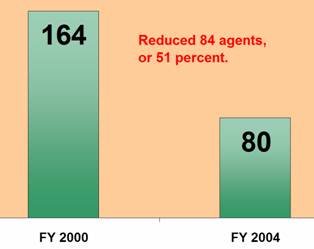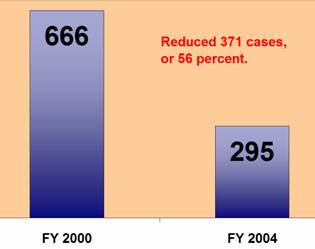Public corruption is the FBI’s highest criminal investigative priority, and its fourth highest priority overall. The FBI has the authority to investigate corruption across all levels of government – local, state, and federal – and across all branches – legislative, executive, and judicial. Consequently, the FBI is the primary investigative agency for public corruption matters. Local law enforcement agencies and federal Offices of Inspectors General also investigate corruption matters involving employees of their respective agencies.
According to FBI field managers, public corruption investigations often require difficult, time-consuming source development. USAO officials agreed with these statements and noted that public corruption cases take longer to develop than other public integrity cases, such as government fraud, due to the complex and sensitive nature of the investigations.
Statistical Evaluation of FBI Public Corruption Efforts
The FBI’s public corruption resource allocations are included within its white-collar crime allotments and are not specifically identified as public corruption allocations. Therefore, we could not determine specific funded staffing levels (FSL) for public corruption matters. However, we were able to evaluate the actual FBI agent utilization in the public corruption area. Overall, between FYs 2000 and 2004, the FBI utilized 36 (or 8 percent) fewer agents on public corruption matters, decreasing from 465 agents in FY 2000 to 429 agents in FY 2004. The FBI initiated 849 public corruption cases during FY 2000 and 834 such cases during FY 2004. Viewing the FBI’s activity through a different lens, we found that the number of serials inputted in public corruption cases declined 23 percent between FYs 2000 and 2004.
Using fewer resources and opening fewer public corruption cases, the FBI forwarded 63 fewer public corruption matters to the USAOs comparing FYs 2000 and 2004 – 673 referrals in FY 2000 compared to 610 in FY 2004. This 9-percent decline correlated with the USAOs’ overall 7-percent decline in public corruption matters received from all agencies. The FBI accounted for about 75 percent of public corruption matters received by the USAOs in both FYs 2000 and 2004.
FBI Field Divisions
We also conducted agent utilization analyses at the field level and looked specifically at the seven field divisions that we visited. As Exhibit 10‑1 demonstrates, FBI field divisions experienced disparate changes between FYs 2000 and 2004 in their level of public corruption effort. While the Chicago Division increased the number of agents investigating public corruption by seven agents, the Los Angeles and New York City Divisions each decreased by six and eight agents, respectively.
| EXHIBIT 10-1
FBI FIELD AGENT UTILIZATION AND CASE OPENINGS ON PUBLIC CORRUPTION MATTERS AT DIVISIONS VISITED FISCAL YEARS 2000 AND 2004 |
||||||
|---|---|---|---|---|---|---|
| Agent Utilization | Case Openings | |||||
| Field Division | FY 2000 | FY 2004 | Change | FY 2000 | FY 2004 | Change |
| Chicago | 23 | 30 | 7 | 34 | 40 | 6 |
| Los Angeles | 20 | 14 | -6 | 29 | 40 | 11 |
| Miami | 13 | 17 | 4 | 47 | 18 | -29 |
| New Orleans | 20 | 23 | 3 | 22 | 20 | -2 |
| New York City | 25 | 17 | -8 | 18 | 19 | 1 |
| Phoenix | 9 | 12 | 3 | 18 | 17 | -1 |
| San Francisco | 8 | 9 | 1 | 12 | 14 | 2 |
| Source: OIG analysis of FBI TURK and ACS data |
Additional analyses of FBI ACS data for these field offices reflected differing results – some offices opened more cases during FY 2004 than during FY 2000, while others initiated fewer investigations. One of the most noticeable changes occurred within the Miami Field Office. In FY 2000, Miami opened 47 public corruption cases compared to 18 in FY 2004, a 62 percent reduction. In contrast, the Los Angeles Field Office opened 35 percent more public corruption cases in FY 2004 than it had in FY 2000, moving from 29 investigations in FY 2000 to 40 in FY 2004, even though it utilized fewer agents on public corruption matters during this time period.
Public Corruption’s Priority Status
Our fieldwork indicated that some FBI offices assessed their public corruption efforts and decided that changes were necessary to adequately combat this high priority crime area. For instance, although the Phoenix Field Office had reduced the number of its white-collar crime squads from five to two, the two remaining squads primarily focused on addressing public corruption matters. Similarly, the Miami Field Office devoted two squads to combat the significant corruption problems in South Florida.
At the New Orleans Field Office, public corruption was placed ahead of cyber crime in its prioritization of investigations because of the problem public corruption posed in the New Orleans area. In fact, according to FBI officials, the New Orleans Field Office has the third largest public corruption problem in the country. To address these issues, the office established a separate public corruption squad at its Baton Rouge Resident Agency.
However, it appeared that some field offices were not giving these matters sufficient priority. For example, FBI officials in the New York City Division stated to us that since New York City is a premier financial center, corporate fraud and high-profile bank fraud matters must be considered a higher priority than public corruption. As a result, the New York City Division experienced a reduction in agent utilization on public corruption matters during FY 2004 as compared to FY 2000, while case openings remained relatively static over the same period of time.
In January 2005, the FBI initiated an effort to review the public corruption efforts within its field offices. As a result, the New York City Division was developing a second public corruption squad to provide additional resources to investigate public corruption within the Division’s jurisdiction. Further, at our exit conference the FBI provided evidence that it had significantly increased its public corruption efforts in FY 2005 compared to FY 2004.
Impact of Public Corruption Emphasis
FBI field division managers stated that any additional public corruption resources they received were often agents transferred from government contract fraud investigations. Therefore, according to FBI field managers, many government contract squads within FBI field divisions were reduced, rolled into general white-collar crime squads, or completely eliminated.
For instance, the Chicago Division previously had a public corruption squad and a government contract squad. Currently, the office operates two public corruption squads and no government contract squad. Similarly, the FBI’s New York City Division indicated that it intends to follow Chicago’s lead and convert its only government contract fraud squad into its second public corruption squad.
Exhibit 10‑2 shows the changes in agent utilization and case openings in government fraud matters for FYs 2000 and 2004. The data shows that agent resources investigating these matters were reduced by 51 percent, while case openings declined by 56 percent.
| EXHIBIT 10-2
OVERALL FBI EFFORTS ON GOVERNMENT FRAUD MATTERS FISCAL YEARS 2000 AND 2004 |
|
|---|---|
| AGENT UTILIZATION | CASE OPENINGS |
 |
 |
| Source: OIG analysis of FBI TURK and ACS data | |
We also reviewed agent utilization and casework data at the field office level. As evidenced in Exhibit 10‑3, all the field offices that we visited experienced decreases in agent utilization for government fraud matters from FY 2000 to FY 2004. The data shows that the San Francisco Division did not have a single agent investigating government contract fraud during FY 2004. By contrast, the Los Angeles Division utilized 12 agents on government fraud matters in FY 2004. Compared to FY 2000, each office opened fewer government fraud cases during FY 2004. In fact, all offices except New Orleans experienced case opening reductions in excess of 50 percent compared to FY 2000 figures.
| EXHIBIT 10-3
FBI FIELD AGENT UTILIZATION AND CASE OPENINGS ON GOVERNMENT FRAUD MATTERS AT DIVISIONS VISITED FISCAL YEARS 2000 AND 2004 |
||||||
|---|---|---|---|---|---|---|
| Agent Utilization | Case Openings | |||||
| Field Division | FY 2000 | FY 2004 | Change | FY 2000 | FY 2004 | Change |
| Chicago | 8 | 4 | -4 | 25 | 2 | -23 |
| Los Angeles | 17 | 12 | -5 | 47 | 16 | -31 |
| Miami | 3 | 1 | -2 | 4 | 0 | -4 |
| New Orleans | 3 | 2 | -1 | 15 | 8 | -7 |
| New York City | 9 | 4 | -5 | 21 | 8 | -13 |
| Phoenix | 4 | 1 | -3 | 9 | 3 | -6 |
| San Francisco | 7 | 0 | -7 | 7 | 3 | -4 |
| Source: OIG analysis of FBI TURK and ACS data |
Although public corruption is the FBI’s fourth highest national priority, the FBI utilized fewer resources in this area in FY 2004 than it did in FY 2000. This decline resulted in fewer case openings during FY 2004 and less activity in public corruption cases, as evidenced by the 23-percent decline in case serials. Additionally, the FBI’s reduced investigative efforts corresponded with fewer public corruption matters referred to the USAOs.


